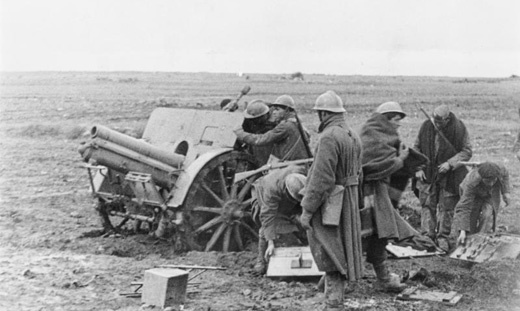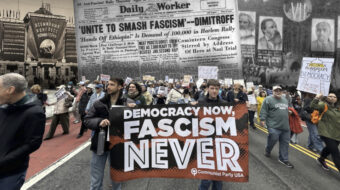
This week the world commemorates two tragic anniversaries.
July 18, 1936, marked the beginning of the fascist-military uprising that led to the Spanish Civil War and 38 years of brutal reactionary rule in Spain.
The event has transcendent relevance for our country and our times.
In 1931, the King of Spain, Alfonso XIII, went into exile and the Spanish Republic was declared. There followed five wild years of jockeying for power between left and right, until in February 1936, national parliamentary elections were won by the Popular Front, a coalition of 15 left-wing and centrist parties which included socialists, communists, Catalan, Valencian and Galician nationalists, and non-socialist democrats.
The Popular Front government, headed briefly by Prime Minister Manuel Azaña of the moderate Republican Left Party, who was quickly succeeded by Santiago Cáceres Quiroga, another moderate, began to undertake some cautious reforms of landholding, labor law, the education system and the military. But this was too much for the Spanish ruling class and the political right. The landowning aristocracy, the Roman Catholic Church, big business and the military officers’ corps all felt threatened by these moderate steps toward a Spain of greater social justice. Right-wing nationalists were horrified by the government’s granting of autonomy to the Catalans and Basques.
The most powerful political party of the right, the Spanish Confederation of Autonomous Right-Wing Groups (CEDA) and its allies did not have the votes to defeat the Popular Front’s measures in the Cortes, the Spanish parliament, so began a campaign of destabilization while also reaching out to the small fascist organization, the Falange Española y de las Juntas de Ofensiva Nacional-Sindicalistas (the Spanish Falange of National Syndicalist Offensive Committees), which acted in an extraparliamentary, hell-raising capacity to promote chaos. Meanwhile, poor peasants and sections of the working class, unsatisfied with the slow speed of the government’s reforms, also opted for sometimes violent direct action, often under anarchist leadership.
The CEDA leader, José María Gil-Robles y Quiñones, hid his relationships to the out-and-out fascists while working with feverish energy to pull all the threads of the right together and to undermine the elected Popular Front government in every way. The fuse was laid. What was needed was a spark.
That came on July 13, 1936, when José Calvo Sotelo, the leader of the strongest right-wing monarchist movement in the Spanish parliament, the Renovación Española, which worked for the return of King Alfonso, was killed by a pro-government police officer who was angry because the fascists had killed a colleague of his.
All the forces of the right now united to support a military uprising, led at the outset by the four generals José Sanjurjo, Gonzalo Queipo de Llano, Francisco Franco and Emilio Mola. Units of the Spanish colonial army in North Africa were induced to mutiny, killed all military and civilian officials who tried to stop them, and quickly managed to cross over into Spain and join up with rebellious officers there, as well as militias organized by the Falangists and other right-wing groups. Sanjurjo and Mola died in airplane accidents, and Francisco Franco became the military leader of the revolt – a role which Sanjurjo had originally envisioned for himself.
There ensued an extremely bloody war which lasted until April of 1939. As the fascists moved through towns and villages they rounded up anyone suspected of being a communist, socialist, anarchist, freemason, Jew, labor union activist or official of the Popular Front government, and a lot of other people besides, and murdered them, sometimes in the most sadistic fashion they could think of. Paul Preston documents all this in horrifying detail in his 2012 book “The Spanish Holocaust: Inquisition and Extermination in 20th Century Spain.” The mass executions continued after the end of the war. Several hundred thousand were eventually killed. In this endeavor Franco and the Falangist-fascists received massive aid from Hitler and Mussolini. The Spanish Republic received aid only from the Soviet Union and to a lesser extent from Mexico. Many leaders in the so-called “democracies” gave de facto support to the Franco regime.
Franco stayed in power until his death in November 1976. During his reign labor unions, intellectuals, the press and the supporters of the rights of minorities, particularly Catalans and Basques, were suppressed. This did not stop the leaders of the NATO powers from allying with Fascist Spain, for Franco was, after all, an “anti-communist.”
When Franco died, there was a partial democratization process, but the old fascist spirit survived, and survives, in sectors of Spanish society. The People’s Party (Partido Popular) of the current right-wing prime minister, Mariano Rajoy, has links to the Franco days, and has actively worked to stop any kind of accounting for the murders the dictatorship committed, even by opposing the disinterment of mass graves of the victims of fascism. Founders of the People’s Party’s predecessor, the People’s Alliance (Alianza Popular), included ministers and other leading figures from the later period of Franco’s rule. Ironically, the Catholic Church eventually apologized for its role during the Civil War and the dictatorship. But the political right, doing the work of transnational corporations and the Spanish ruling class, still seeks to impose draconian austerity on the working class.
Spain has not yet recovered from the Spanish Civil War and the 38 years of the Franco dictatorship. No punishment has ever been meted out to surviving figures of the Franco regime, and it has been a struggle even to get the bodies of Franco’s victims disinterred from the mass graves all over the country in which they lie.
We in the United States should learn from the Spanish Civil War and the Franco dictatorship. Once the extreme right builds itself up to a sufficient level of strength to gain power and impose a repressive and anti-democratic regime, it may take many decades to oust it from power, and nobody knows how long to reverse the damage it has done to the social fabric. Hitler was only defeated when the Soviet army captured Berlin in 1945, and he committed suicide. Mussolini was ousted only when it became clear that Italy would suffer a disastrous rout in World War II.
The lesson is: “Never again.”
Photo: Troops at Guadalajara, 1937, Spanish Civil War. | Wikipedia (CC)










